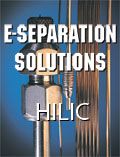The LCGC Blog: Diode Array Detector Settings - Five Minutes to Change Your Chromatography Forever
E-Separation Solutions
Of late we have been running a series called 'Lock and Leave', which serves as a reminder to pay attention to those instrument parameters which are often overlooked - you know the type of thing ? 'that's the best value for this system?, 'we always set to that value' and 'I have no idea what that does' ? it's always at that value'.
In another role of mine, I deliver webcasts on analytical chemistry for our e-learning site CHROMacademy. Of late we have been running a series called ‘Lock and Leave’, which serves as a reminder to pay attention to those instrument parameters which are often overlooked - you know the type of thing – ‘that’s the best value for this system’, ‘ we always set to that value’ and ‘I have no idea what that does – it’s always at that value’.
We ran a short session on Diode Array detector settings, as I feel the effects of these variables are generally poorly understood. I couldn’t have imagined the response we had – folks really loved the help and having a better insight into how to radically change the quality of their chromatography. I thought I would share these quick tips with you so you never again have to say ‘I have no idea what that does’.
Figure 1: Schematic diagram of the major components of a reversed optics diode array detector
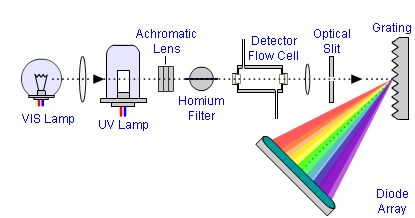
As an attention grabber I should state that the benefits of getting the UV detector settings correct include; improved signal to noise ratio (and hence sensitivity), reduction in baseline drift (better quantitative reproducibility), improved qualitative data (improved confidence in peak purity and other qualitative data analysis).
As usual the variable (setting / parameter) names used differ between manufacturers, however, most or all of the variables described below are common to all instruments – i.e. we need to consider each of them. At this point I should say that it’s worth investing a little up front time to understand your methods to make sure your detector settings are optimised. Yes – I know that you are all busy beyond belief, but you would be amazed at the number of folks I’ve worked with to whom I have demonstrated that a little up front development and understanding leads to huge time and efficiency savings down the line. So dig deep and make the effort – you will be rewarded.
Data Sampling Points and Range
Shown above is a typical photodiode array with 1024 elements. In simple terms, the emergent light from the flow cell can be split into 1024 separate parts, and in typical HPLC UV applications, this will mean that each diode will be able to measure light over a range <1nm and each individual wavelength in the chosen range can be individually measured if required. For good quality qualitative measurements you need to record each wavelength and don’t bunch data to reduce data file size.
Ensure the wavelength range is wide enough to cover your acquisition wavelength plus a good reference window (see below) – typical values are 200-400 nm or higher if you are working with compounds in the visible range (>350nm), in which case you will probably need to use a tungsten lamp, if there is one fitted.
Figure 2: : A photo diode array

A typical photodiode array with 1024 elements is shown in Figure 2. In simple terms, the emergent light from the flow cell can be split into 1024 separate parts, and in typical HPLC UV applications, this will mean that each diode will be able to measure light over a range <1 nm and each individual wavelength in the chosen range can be individually measured if required. For good quality qualitative measurements you need to record each wavelength and don’t bunch data to reduce data file size.
Ensure the wavelength range is wide enough to cover your acquisition wavelength plus a good reference window (see below) – typical values are 200-400 nm or higher if you are working with compounds in the visible range (>350 nm), in which case you will probably need to use a tungsten lamp, if there is one fitted.
Acquisition and Reference Wavelengths and Bandwidths
The acquisition wavelength should be chosen so that maximum signal intensity is acquired with a manageable background noise level. This is usually managed with a setting called bandwidth, signal width or noise and represents the number of wavelengths around the chosen value which are measured in order to calculate the absorbance; i.e. 254 nm with a bandwidth of 40 nm would record the light falling on the diodes corresponding to the range 234–274 nm.
Remember that to avoid sloping baselines during gradient elution (Figure 3), one should avoid monitoring at lower wavelengths as solvents and additives are more likely to absorb in these regions (Table 1), and any change in the absorbance of the eluent (i.e. as the composition changes during gradient analysis) will lead to baseline drift effects.
Figure 3: Comparison of baseline drift using methanol and acetonitrile at different acquisition wavelength »
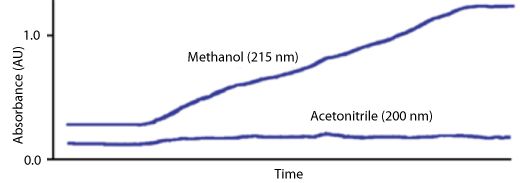
Table 1: UV cut off for common
HPLC solvents Solvent
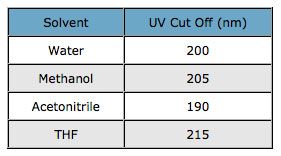
The first change to your usual routine is that you will need to look at the UV spectra for all analyte peaks of interest; however, these should be very easy to obtain from your data system. Make sure you are looking at the 0th order spectra rather than a derivative (1st, 2nd order etc.). Follow the steps below to obtain the most appropriate acquisition and reference wavelengths, and note that it is possible with most instruments to record separate signals for each analyte in order to obtain the optimum spectral intensity and best baseline.

Figure 4: Determining acquisition wavelength and bandwidth from a 0th order UV spectrum of phenanthrene.
From Figure 4 we can see that the acquisition wavelength is typically chosen to coincide with the maximum absorption from the UV spectrum. The bandwidth is set according to the width of the spectral feature at 50% of the maximum absorbance as shown.
From figure 5 we can see that the reference wavelength is set at 60 nm higher than the first point at which the absorbance falls below 1 mAU = 310 nm + 60 nm = 370 nm. Figure 5a demonstrates the effects on signal and noise when different reference wavelengths are chosen.
Reference bandwidth is an arbitrary choice depending upon noise obtained but is typically 100 nm, to give minimal baseline drift due to changes in Refractive Index as the eluent composition changes, as well as minimum noise. Figure 5b demonstrates the effects of changing reference bandwidth on a typical HPLC separation.
One must ensure that the lower end of the reference window is well away from the absorbance region of any analyte species which are being measured using the signal or channel, otherwise quantitative errors may occur.
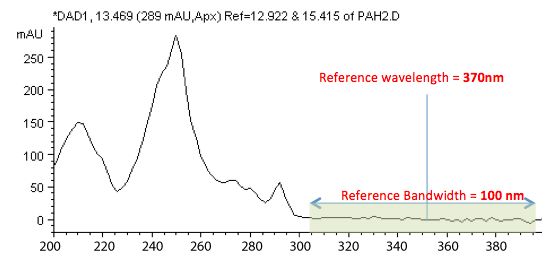
Figure 5: Determining reference wavelength and bandwidth from a 0th order UV spectrum of phenanthrene.
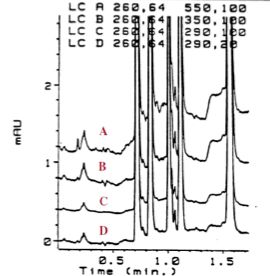
Figure 5a: Effect of different Reference Wavelengths on signal and noise in a typical HPLC separation (Courtesy of Agilent Technologies, Santa Clara, Ca, USA).
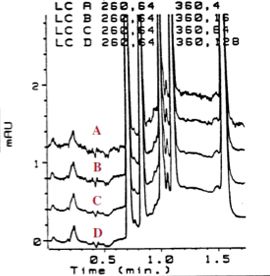
Figure 5b: Effect of different Reference Bandwidths on signal and noise in a typical HPLC separation (Courtesy of Agilent Technologies, Santa Clara, Ca, USA).
Spectral Settings
Spectral Bandwidth or Resolution settings need to be balanced between qualitative and quantitative requirements. Because the bandwidth parameter effectively ‘averages’ response over a fewer or greater number of diodes, larger bandwidths result in better signal to noise ratio as the noise falls off more quickly than the signal. However this ‘averaging’ also results in the loss of spectral features as is explained in Figure 6.

Figure 6: Effect of bandwidth on signal/noise ratio and spectral resolution.
If qualitative analysis is required, for example if peak purity measurement or compound identification is required, then narrower bandwidths are typically chosen. Conversely wider bandwidths are chosen to optimise detector sensitivity.
The Slit Width setting behaves in much the same way as the bandwidth setting but instead of averaging the light over a fewer or greater number of diodes, it effectively focusses the light which falls upon the diode array, in a similar way that an aperture focusses the image in a camera.
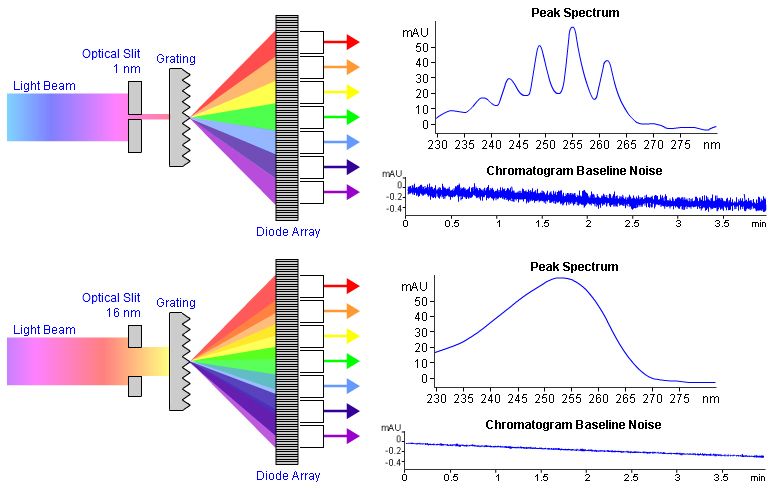
Figure 7: Wider slit widths give less baseline noise at the expense of lost spectral resolution and vice versa.
As can be seen in Figure 7, wider slit widths are better used for quantitative analysis and narrower slit widths for qualitative analysis. A slit width of 4 or 8 nm is often a good compromise.
Acquisition Rate
Finally, the peak width or response time or data acquisition rate setting must be optimised. Various manufacturers have various names for the parameter and various methods for empirically determining the optimum setting and one should refer to manufacturer’s literature for this. However, the fundamental principles are consistent in that one must obtain at least 25 data points across the peak for quantitative data analysis and one can ascertain this by taking a spectrum (scan) at the start and end of the peak and subtracting the scan numbers. A figure of 25 or higher should be obtained. If a lower figure is obtained then increase the sample rate (or decrease the response time).
Higher data sampling rates increase baseline noise but also often increase the signal height due to more accurate modelling of the peak shape as is shown in Figure 8 and 8a.
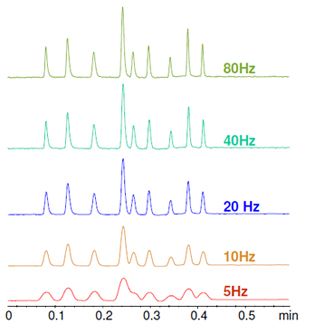
Response time is defined as the time taken for a chart recorder to reach 90% of its full scale deflection and then return to the baseline position
Figure 8: Effect of response time on baseline noise.
Figure 8a: Effect of data acquisition rate on efficiency, resolution, and sensitivity.
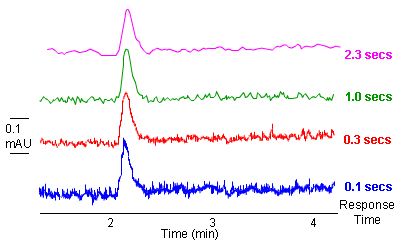
As can be seen in Figure 8a, data acquisition rate can have a significant effect on efficiency, resolution, and sensitivity of a separation and needs to be carefully optimised.
For more information – contact either
Bev ([email protected]) or Colin ([email protected]).
For more tutorials on LC, GC, or MS, or to try a free LC or GC troubleshooting tool, please visit www.chromacademy.com
The LCGC Blog: Historical (Analytical) Chemistry Landmarks
November 1st 2024The American Chemical Society’s National Historic Chemical Landmarks program highlights sites and people that are important to the field of chemistry. How are analytical chemistry and separation science recognized within this program?

.png&w=3840&q=75)

.png&w=3840&q=75)



.png&w=3840&q=75)



.png&w=3840&q=75)
